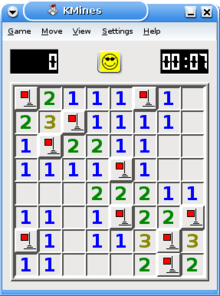Puzzle video game
Puzzle video games make up a broad genre of video games that emphasize puzzle solving. The types of puzzles can test many problem-solving skills including logic, pattern recognition, sequence solving, spatial recognition, and word completion.
| Part of a series on | ||||||||||||
| Puzzles | ||||||||||||
|---|---|---|---|---|---|---|---|---|---|---|---|---|
 | ||||||||||||
|
Types
|
||||||||||||
|
Topics
|
||||||||||||
|
Lists
|
||||||||||||
Definition and gameplay
Puzzle games focus on logical and conceptual challenges. While many action games and adventure games include puzzle elements in level design, a true puzzle game focuses on puzzle solving as its primary gameplay activity.[1]
Rather than presenting a random collection of puzzles to solve, puzzle games typically offer a series of related puzzles that are a variation on a single theme. This theme could involve pattern recognition, logic, or understanding a process. These games usually have a set of rules, where players manipulate game pieces on a grid, network or other interaction space. Players must unravel clues in order to achieve some victory condition, which will then allow them to advance to the next level. Completing each puzzle will usually lead to a more difficult challenge.[1]
Puzzle games can include:
- Matching objects based on categories (e.g. patterns, colors, shapes, symbols, etc.)
- Visualizing and manipulating objects in space and time
- Memorizing complex patterns
- Tackling increasing complexities of puzzles that build upon previous puzzles
- Solving puzzles under a time constraint or limited-life constraint.
- Applying previous-known knowledge about the world
- Thinking outside of the box
Types of puzzle games

There is a large variety of puzzle game types. Some feed to the player a random assortment of blocks or pieces that they must organize in the correct manner. Others present a preset game board or pieces and challenge the player to solve the puzzle by achieving a goal.
Puzzle games are often easy to develop and adapt, being implemented on dedicated arcade units, home video game consoles, personal digital assistants, and mobile phones.
Logical
Logical puzzle games exhibit logic and mechanisms that are consistent throughout the entire game. Solving them typically require deductive reasoning skills.
Physics game

A physics game is a type of logical puzzle video game wherein the player must use the game's physics and environment to complete each puzzle. Physics games use consistent physics to make games more challenging.[2] The genre is especially popular in online flash games and mobile games. Educators have used these games to demonstrate principles of physics.[3]
Popular physics-based logic puzzle games include Portal, The Talos Principle, The Witness, Braid, Fez, World of Goo, and Cut the Rope.
These also include projectile collision games such as Angry Birds, Peggle, Monster Strike, and Crush the Castle.
Coding
These are logical puzzle games that require programming elements. Examples include The Incredible Machine, SpaceChem, and Infinifactory.
Trial-and-Error
This sub-genre includes point-n-click games that often exhibit similarities with adventure games and walking simulators. Unlike logical puzzle games, these games generally require inductive reasoning to solve. The defining trait is that you must experiment with mechanisms in each level before you can solve them. Puzzle elements often do not have consistency throughout the game, and thus require guessing and checking.
These include Myst, Limbo, The Dig, Monument Valley, and escape room games such as The Room.
Hidden object game
A hidden object game (sometimes called hidden picture or hidden object puzzle adventure (HOPA)) is a genre of puzzle video game in which the player must find items from a list that are hidden within a picture.[4] Hidden object games are a popular trend in casual gaming,[5][6] and are comparatively inexpensive to buy.[4][5] Time-limited trial versions of these games are usually available for download.
An early hidden object game was Alice: An Interactive Museum. Computer Gaming World reported in 1993 that "one disadvantage of searching through screen after screen for 'switches' is that after a while one develops a case of 'clickitus' of the fingers as one repeatedly punches that mouse button like a chicken pecking at a farmyard".[7] Other early incarnations are the video game adaptations of the I Spy books published by Scholastic Corporation since 1997.
Publishers of hidden object games include Sandlot Games, Big Fish Games, Awem Studio, SpinTop Games, and Codeminion.[4] Examples of hidden object game series include Awakening, Antique Road Trip (both by Boomzap Entertainment), Dream Chronicles (PlayFirst), Mortimer Beckett (RealArcade/GameHouse), Mystery Trackers (by Elephant Games), Hidden Expedition and Mystery Case Files (both by Big Fish Games).[8]
Reveal the picture game
A reveal the picture game is a type of puzzle game that features piece-by-piece revealing of a photo or picture.
Tile-matching
In tile-matching video games, the player manipulates tiles in order to make them disappear according to a matching criterion. The genre began with 1985's Chain Shot! and has similarities to "falling block" games such as Tetris. This genre includes games that require pieces to be swapped such as Bejeweled or Candy Crush Saga, games that adapt the classic tile-based game Mahjong such as Mahjong Trails, and games in which are pieces are shot on the board such as Zuma. Puzzle games based on Tetris include In many recent tile-matching games, the matching criterion is to place a given number of tiles of the same type so that they adjoin each other. That number is often three, and the corresponding subset of tile-matching games is referred to as "match-three games."
Other examples include Threes, Picross, and Lumines.
Traditional puzzle
There have also been many digital adaptations of traditional puzzle games, including solitaire and mahjong solitaire. Even familiar word puzzles, number puzzles, and association puzzles have been adapted as games such as Dr. Kawashima's Brain Training.[9]
History
Origins and popularity
Puzzle video games owe their origins to brain teasers and puzzles throughout human history. The mathematical strategy game Nim, and other traditional, thinking games, such as Hangman and Bulls and Cows (commercialized as Mastermind), were popular targets for computer implementation.
The University of Tokyo's 1979 Heiankyo Alien for the PC-8001 and arcades was an early "trap 'em up" puzzle action game. It was a precursor to later puzzle action games such as Lode Runner.[10] Another early action game with puzzle elements was Konami's Loco-Motion (1982), elements of which are seen in Pipe Mania from LucasArts (1989).
Blockbuster, by Alan Griesemer and Stephen Bradshaw (Atari 8-bit, 1981), is a computerized version of the Rubik's Cube puzzle.[11] Snark Hunt (Atari 8-bit, 1982) is a single-player game of logical deduction,[12] a clone of the 1970s Black Box board game. Sokoban's crate-pushing puzzles from 1982 have been widely cloned and its core mechanic incorporated into other games.
Other early puzzle games include puzzle-platformers such as Door Door (1983),[13] Lode Runner (1983), and Doki Doki Penguin Land (1985).[14]
1984's Puzzle Panic for the Atari 8-bit computers specifically uses the word puzzle in the game's title. 1984 also saw the release of the action-puzzle game Boulder Dash, where the goal is to collect diamonds while avoiding or exploiting rocks that fall when the dirt beneath them is removed. It led to a number of clones categorized as "rocks and diamonds games."
In 1985, Chain Shot! introduced removing groups of the same color tiles on a grid, then the remaining tiles falling into the created gap.[15] Uncle Henry's Nuclear Waste Dump (1986) has similarities to Tetris, though it was published prior to Tetris reaching the US, and the author claims he hadn't seen it.[16]
Refinement
1991 saw the release of Lemmings.[17] The game involves a series of creatures who mindlessly walk into deadly situations, and the player assigns jobs to specific lemmings to guide the swarm to a safe destination.[18]
1994 was marked by a surge in interest in mahjong video games from Japan.[19][20]
When Minesweeper was released with Windows 95, mainstream audiences embraced using a mouse to play puzzle games.[21]
Modern puzzle games
In 2001, PopCap Games released a graphically-enhanced clone of an obscure 1994 MS-DOS game, Shariki,[22] where the player must touch groups of three or more jewels on a grid, causing them to disappear and new stones to fall into place. A decade later, the match three mechanic was the foundation for popular games, including Candy Crush Saga and Puzzle & Dragons, both from 2012.
Since the release of Portal in 2007, there has been a rise in popularity of physics-based logic puzzle games such as Braid, The Talos Principle, and The Witness,
By 2014, puzzle games had become the largest genre in the iOS App Store.[23]
See also
- List of puzzle video games
- Escape the room
References
- Rollings, Andrew; Ernest Adams (2006). Fundamentals of Game Design. Prentice Hall.
- Ward, Mark (2005-05-14). "Game physics starts to get real". BBC News. Retrieved 2010-03-27.
- Thompson, Jane (2007-06-15). "Video games getting deeper". The Star. Retrieved 2010-03-27.
- "Ally Noble Desert Island Disks". Retro Gamer. Imagine Publishing (53): 79.
Hidden object games ... For example, you're a detective looking for clues in a picture ... they might be in monochrome on the wallpaper or peeping out from behind something.
- George Roush (October 17, 2008). "Everest: Hidden Expedition iPhone Review". IGN. Archived from the original on February 24, 2009.
- Albert Kim (September 30, 2008). "Casual Games: 'Peggle Nights' and 'The Lost Cases of Sherlock Holmes'". EW.com.
Mystery titles, particularly hidden-object games, have become a hugely popular segment of the casual-game market.
- Reveaux, Tony (April 1993). "A Trip Into The Odd Land of Multi-Media". Computer Gaming World. p. 40. Retrieved 6 July 2014.
- "First casual game with a 'Collector's Edition'". Game Hunters. USA Today. November 27, 2009. Retrieved 2009-11-30.
- Jim Thompson; Barnaby Berbank-Green; Nic Cusworth. Game design course: principles, practice, and techniques. Wiley. pp. 30–31.
- Parish, Jeremy (28 August 2014). "Greatest Years in Gaming History: 1983".
- "Blockbuster". Atari 8-bit Forever. Archived from the original on 2015-12-07.
- Powell, Jordan (February 1983). "Ten Best from APX". Antic. http://www.atarimagazines.com/v1n6/tenbestfromapx.html.
- "Door Door". GameSpot. Archived from the original on 28 July 2012. Retrieved 13 September 2011.
- "DokiDoki Penguin Land for SG-1000 - GameFAQs". Retrieved 3 April 2017.
- Juul, Jesper. "Swap Adjacent Gems to Make Sets of Three: A History of Matching Tile Games".
- "Accidental Innovation, Part 1".
- Rusel DeMaria; Johnny L. Wilson. High score!: the illustrated history of electronic games. McGraw Hill.
- Miller, Skyler. "History of Puzzle Games". GameSpot. Archived from the original on 2010-02-04. Retrieved 25 September 2016.
- Mark J. P. Wolf. The video game explosion: a history from PONG to Playstation and beyond. Greenwood Publishing Group.
- Gameplay Net, GamePlay.Net, 2014, retrieved February 1, 2014
- Jeff Fulton; Steve Fulton. The Essential Guide to Flash Games. Apress.
- Hester, Larry (October 21, 2013). "Inside Bejeweled: An Interview with Executive Producer Heather Hazen". Complex.
- Hill, Simon (December 15, 2014). "Games rule the iTunes App Store: Most popular genres revealed".